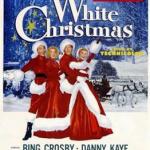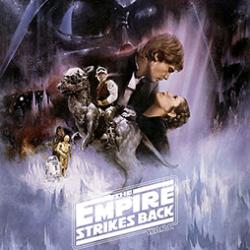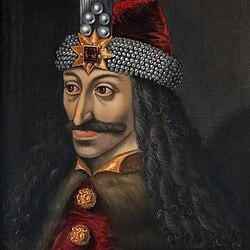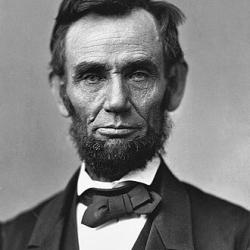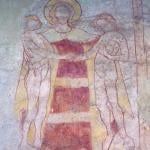There is nothing quite like getting together with a bunch of O-Come All Ye faithful Joy to the World filled singers and belting out carols on a Christmasy Silent Night. Before Santa creeped in and began to secularize Christmas, most songs belted out at the yuletide season were focused on a baby born Away in a Manger in the Little Town of Bethlehem while Herald Angels Sing. Not that there is nothing wrong with songs about Santa and Snow, but to sing of the birth of the non-material creator of the universe becoming flesh in a baby to redeem a fallen world is more exciting then a jolly old elf flying around the world advertising Coke and giving toys to good girls and boys. Not that there is anything wrong with that.
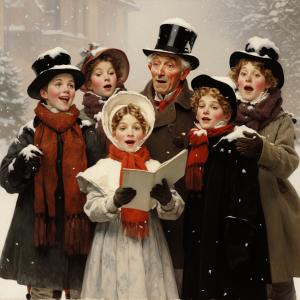
Did you know that despite this long history and centuries of music dedicated to the birth of Christ many Christmas carols and their translations and versions of the songs we know today as well as originals, some based on poems date only from the nineteenth century onwards, with the exception of songs such as the “God Rest You Merry Gentlemen“, “The Holly and the Ivy” the “Coventry Carol” and “I Saw Three Ships” and the
Good people all, this Christmas time,
Consider well and bear in mind
What our good God for us has done
In sending His beloved Son
With Mary holy we should pray,
To God with love this Christmas Day
In Bethlehem upon that morn,
There was a blessed Messiah born.
The practice of ordinary Christian church members of various denominations going door to door and singing carols, asking for figgy pudding continues in many parts of the world, such as in India; residents give money to the carolers, which churches distribute to the poor.
Unless said otherwise, descriptions of songs are taken from Wikipedia.
19th Century
Here We Come A-wassailing (19th Century): The song dates from at least the mid 19th century, but is probably much older. The a- in “a-wassailing” is an archaic intensifying prefix; compare “A-Hunting We Will Go” and lyrics to “The Twelve Days of Christmas” (e.g., “Six geese a-laying”).
Here we come a-wassailing
Among the leaves so green;
here we come a-wand’ring
so fair to be seen.
Refrain:
Love and joy come to you,
and to you your wassail too;
and God bless you and send you a happy New Year,
and God send you a happy New Year.
Angels, from the Realms of Glory (1816): This hymn-carol by Moravian poet-editor James Montgomery (1771–1854) first appeared in The Iris, or The Sheffield Advertiser, vol. 30, no. 1543, 24 December 1816 (Christmas Eve), where it was called “The Nativity” and attributed to “J.M.” (Fig. 1). Montgomery had been editor of the paper since 1794. In this printing, the hymn contained five stanzas of six lines.— Hymnology Archive
Angels, from the realms of glory,
Wing your flight o’er all the earth;
Ye who sang creation’s story,
Now proclaim Messiah’s birth:
Refrain: Come and worship,
Come and worship
Worship Christ, the newborn King.
The Coventry Carol, (1817)- For the Feast of the Holy Innocents, December 28- is an English Christmas carol dating from the 16th century. The carol was traditionally performed in Coventry in England as part of a mystery play called The Pageant of the Shearmen and Tailors. The play depicts the Christmas story from chapter two in the Gospel of Matthew: the carol itself refers to the Massacre of the Innocents, in which Herod ordered all male infants under the age of two in Bethlehem to be killed, and takes the form of a lullaby sung by mothers of the doomed children.
A version of this carol was written by Thomas Sharp, 1817 & 1825. – Sharp (1817).
Lully, lullah, thou little tiny child,
Bye bye, lully, lullay.
Thou little tiny child,
Bye bye, lully, lullay.
Silent Night (1818): It composed in 1818 by Franz Xaver Gruber to lyrics by Joseph Mohr in Oberndorf bei Salzburg, Austria. It was declared an intangible cultural heritage by UNESCO in 2011. The song was first recorded in 1905 and has remained a popular success, appearing in films and multiple successful recordings, as well as being quoted in other musical compositions. It is the world’s most recorded Christmas song, with more than 137,000 known recordings.
Silent night! Holy night!
All is calm, all is bright
Round yon virgin mother and child!
Holy infant, so tender and mild,
Sleep in heavenly peace!
Sleep in heavenly peace!
The First Noel (1823): “The First Nowell” is of Cornish origin. Its current form was first published in Carols Ancient and Modern (1823) and Gilbert and Sandys Carols (1833), both of which were edited by William Sandys and arranged and edited by Davies Gilbert (who also wrote extra lyrics) for Hymns and Carols of God.
The first Nowell the angel did say
Was to certain poor shepherds in fields as they lay;
In fields where they lay, keeping their sheep,
On a cold winter’s night that was so deep:
Refrain
Nowell, Nowell, Nowell, Nowell,
Born is the King of Israel.
God Rest You Merry, Gentlemen: (1824) An article in the March 1824 issue of The Gentleman’s Magazine complains that, in London, no Christmas carols are heard “excepting some croaking ballad-singer bawling out ‘God rest you, merry gentlemen’, or a like doggerel”.[15] The carol is referred to in Charles Dickens‘ 1843 novella A Christmas Carol. It is also quoted in George Eliot‘s 1861 novel Silas Marner.
God rest ye, merry Gentlemen,
Let nothing you dismay,
For Jesus Christ our Saviour
Was born upon this Day.
To save poor souls from Satan’s power,
Which long time had gone astray.
Which brings tidings of comfort and joy.
O Tannenbaum (1824): The modern lyrics were written in 1824 by the Leipzig organist, teacher and composer Ernst Anschütz. A Tannenbaum is a fir tree. The lyrics do not actually refer to Christmas, or describe a decorated Christmas tree. Instead, they refer to the fir’s evergreen quality as a symbol of constancy and faithfulness.
O Christmas tree, O Christmas tree!
How are thy leaves so verdant!
Not only in the summertime,
But even in winter is thy prime.
O Christmas tree, O Christmas tree,
How are thy leaves so verdant!
I Saw Three Ships (1833): The earliest printed version of “I Saw Three Ships” is from the 17th century, possibly Derbyshire, and was also published by William Sandys in 1833. An alternate of the song is Sunny Bank .
I saw three ships come sailing in
On Christmas day, on Christmas day;
I saw three ships come sailing in
On Christmas day in the morning.
Angels we have heard on high : (1842) This famous Christmas carol finds its roots in France, where it was first published in Choix de cantiques sur des airs nouveaux (Paris: Poussièlgue-Rusand, 1842 | Fig. 1) as “Les anges, dans nos campagnes” (“The angels in our countryside”), bearing the title “L’ écho des montagnes de Béthléem” (“The echo of the mountains of Bethlehem”). The subheading “Noël Languedocien” means “Languedoc Christmas,” referring to the southern coastline of France, bordering Spain along the Mediterranean Sea. The music was credited to “W.M.” but the vocal parts and accompaniment for the whole collection were arranged by Louis Lambillotte (1796–1855). This early version of the carol includes its familiar tune, set to ten stanzas of text.— Hymnology Archive
Angels we have heard on high
Sweetly singing o’er the plains
And the mountains in reply
Echoing their joyous strains
|: Gloria in excelsis Deo! 😐
O Holy Night(1847): The carol “O Holy Night” is derived from the poem Minuit, chrétiens, written by poet Placide Cappeau in 1847, a wine commissionaire and a part-time poet.
O holy night, the stars are brightly shining;
It is the night of the dear Saviour’s birth.
Long lay the world in sin and error pining,
Till He appeared and the soul felt its worth.
A thrill of hope, the weary world rejoices,
For yonder breaks a new and glorious morn!
Fall on your knees! O hear the angel voices!
O night divine, O night when Christ was born!
O night divine! O night, O night divine!
“Joy to the World“: (1848): This is an English hymn. It was written in 1719 by the English minister and hymnist Isaac Watts. The carol is usually sung to the American composer Lowell Mason‘s 1848 arrangement of a tune attributed to George Frideric Handel. The hymn’s lyrics are a Christian reinterpretation of Psalm 98 and Genesis 3.
Since the 20th century, “Joy to the World” has been the most-published hymn associated with Christmas in North America in spite of not being a Christmas carol. As of December 2009, it was published in 1,387 hymnals in North America, according to the Dictionary of North American Hymnology.
Joy to the world, the Lord is come!
Let earth receive her King;
Let every heart prepare him room,
� And heaven and nature sing, �
And heaven, and heaven, and nature sing.
Once in Royal David’s City (1848): This is a Christmas carol originally written as a poem by Cecil Frances Alexander. The carol was first published in 1848 in her hymnbook Hymns for Little Children. A year later, the English organist Henry Gauntlett discovered the poem and set it to music.
Once in royal David’s city
Stood a lowly cattle shed,
Where a mother laid her baby
In a manger for his bed:
Mary was that Mother mild,
Jesus Christ her little Child.
It Came Upon the Midnight Clear (1849):This is an 1849 poem and Christmas carol written by Edmund Sears, pastor of the Unitarian Church in Wayland, Massachusetts. In 1850, Sears’ lyrics were set to “Carol”, a tune written for the poem the same year at his request, by Richard Storrs Willis. This pairing remains the most popular in the United States, while in Commonwealth countries, the lyrics are set to “Noel”, a later adaptation by Arthur Sullivan from an English melody.
It came upon the midnight clear,
That glorious song of old,
From angels bending near the earth
To touch their harps of gold;
“Peace on the earth, good will to men
From heaven’s all-gracious King” –
The world in solemn stillness lay
To hear the angels sing.
Jingle Bells (1850): This is one of the most commonly sung Christmas songs in the world. It was written in 1850 by James Lord Pierpont at Simpson Tavern in Medford, Massachusetts. It was published under the title “The One Horse Open Sleigh” in September 1857.
Dashing through the snow
In a one-horse open sleigh
O’er the fields we go
Laughing all the way
Bells on bob tail ring
Making spirits bright
What fun it is to ride and sing
A sleighing song tonight!
Oh! Jingle bells, jingle bells,
Jingle all the way.
Oh! what fun it is to ride
In a one-horse open sleigh. Hey!
Jingle bells, jingle bells,
Jingle all the way;
Oh! what fun it is to ride
In a one-horse open sleigh.
O Come, O Come, Emmanuel (1851): The 1851 translation by John Mason Neale from Hymns Ancient and Modern is the most prominent by far in the English-speaking world, but other English translations also exist.
Hymns Ancient and Modern (1861)
O come, O come, Emmanuel,
And ransom captive Israel;
That mourns in lonely exile here,
Until the Son of God appear.
Rejoice! Rejoice! Emmanuel
Shall come to thee, O Israel.
O Come, All Ye Faithful (1852) : O Come, All Ye Faithful“, also known as “Adeste Fideles“, is a Christmas carol that has been attributed to various authors, including John Francis Wade (1711–1786), John Reading (1645–1692), King John IV of Portugal (1604–1656), and anonymous Cistercian monks. The earliest printed version is in a book published by Wade. A manuscript by Wade, dating to 1751, is held by Stonyhurst College in Lancashire.
The text has been translated innumerable times into English. The most common version today is a combination of one of Frederick Oakeley‘s translations of the original four verses, and William Thomas Brooke’s translation of the three additional verses. It was first published in Murray’s Hymnal in 1852. Oakeley originally titled the song “Ye Faithful, approach ye” when it was sung at his Margaret Chapel in Marylebone (London), before it was altered to its current form.
O come, all ye faithful, joyful and triumphant!
O come ye, O come ye to Bethlehem;
Come and behold Him
Born the King of Angels:
O come, let us adore Him, (3×)
Christ the Lord.
Hark! The Herald Angels Sing (1855): In 1855, British musician William Hayman Cummings, organist at Waltham Abbey Church, adapted Felix Mendelssohn‘s secular music from Festgesang to fit the lyrics of “Hark! The Herald Angels Sing” written by Charles Wesley in 1739. Wesley had originally envisioned the words being sung to the same tune as his Easter hymn “Christ the Lord Is Risen Today”
Hark! The herald-angels sing
“Glory to the newborn king;
Peace on earth and mercy mild,
God and sinners reconciled”
Joyful all ye nations rise,
Join the triumph of the skies
With the angelic host proclaim
“Christ is born in Bethlehem”
Hark! The herald-angels sing
“Glory to the new-born king”
We Three Kings (1857): This is a Christmas carol that was written by John Henry Hopkins Jr. in 1857. At the time of composing the carol, Hopkins served as the rector of Christ Episcopal Church in Williamsport, Pennsylvania, and he wrote the carol for a Christmas pageant in New York City. It was the first widely popular Christmas carol written in America.
All
We Three Kings of Orient are,
Bearing gifts we traverse afar,
Field and fountain,
Moor and mountain,
Following yonder Star.
Refrain
O Star of Wonder, Star of Night,
Star with Royal Beauty bright,
Westward leading,
Still proceeding,
Guide us to Thy perfect Light.
Messiah (Handel) (1857) In Britain a “Great Handel Festival” was held at the Crystal Palace in 1857, performing Messiah and other Handel oratorios, with a chorus of 2,000 singers and an orchestra of 500.
While shepherds watched their flocks:(1861) This is a traditional Christmas carol describing the Annunciation to the Shepherds, with words attributed to Irish hymnist, lyricist and England’s Poet Laureate Nahum Tate.The tune and hymn text were probably first published together in an arrangement by William Henry Monk for Hymns Ancient and Modern in 1861.
While shepherds watched their flocks by night,
all seated on the ground,
an angel of the Lord came down,
and glory shone around.
Deck the Halls (1862): The English-language lyrics were written by the Scottish musician Thomas Oliphant. They first appeared in 1862, in volume 2 of Welsh Melodies, a set of four volumes authored by John Thomas, including Welsh words by John Jones (Talhaiarn) and English words by Oliphant.
Deck the hall with boughs of holly,
Fa, la, la, la, la, la, la, la, la!
‘Tis the season to be jolly:
Fa, la, la, la, la, la, la, la, la!
Fill the meadcup, drain the barrel,
Fa, la, la, la, la, la, la, la, la!
Troul the ancient Christmas carol.
Fa, la, la, la, la, la, la, la, la!
I Heard the Bells on Christmas Day (1863): It is a Christmas carol based on the 1863 poem “Christmas Bells” by American poet Henry Wadsworth Longfellow. The song tells of the narrator hearing Christmas bells during the American Civil War, but despairing that “hate is strong and mocks the song of peace on earth, good will to men”. After much anguish and despondency the carol concludes with the bells ringing out with resolution that “God is not dead, nor doth He sleep” and that there will ultimately be “peace on earth, good will to men”. It was not until 1872 that the poem is known to have been set to music.
I heard the bells on Christmas Day
Their old, familiar carols play,
And wild and sweet
The words repeat
Of peace on earth, good-will to men!
And thought how, as the day had come,
The belfries of all Christendom
Had rolled along
The unbroken song
Of peace on earth, good-will to men!
“What Child Is This?” (1865): It is a Christmas carol with lyrics written by William Chatterton Dix in 1865 and set to the tune of “Greensleeves“, a traditional English folk song, in 1871. Although written in Great Britain, the carol today is more popular in the United States than its country of origin.
What child is this, who, laid to rest
On Mary’s lap, is sleeping?
Whom angels greet with anthems sweet
While shepherds watch are keeping?
This, this is Christ the King,
Whom shepherds guard and angels sing;
Haste, haste to bring him laud,
The babe, the son of Mary.
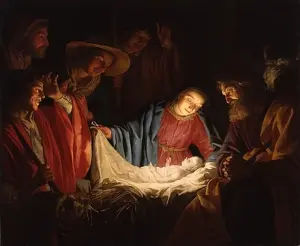
Up on the Housetop: (1864): “Up on the Housetop” is a Christmas song written by Benjamin Hanby in 1864. It has been recorded by a multitude of singers, most notably Gene Autry in 1953.
According to William Studwell in The Christmas Carol Reader, “Up on the Housetop” was the second-oldest secular Christmas song, outdone only by “Jingle Bells“, which was written in 1857. It is also considered the first Yuletide song to focus primarily on Santa Claus. It was originally published in the magazine Our Song Birds by Root & Cady. According to Reader’s Digest Merry Christmas Song Book, Hanby probably owes the idea that Santa and his sleigh land on the roofs of homes to Clement C. Moore’s 1822 poem, “A Visit from St. Nicholas” (also commonly known as “The Night Before Christmas”).
Jolly Old Saint Nicholas (1865): It is a Christmas song that originated with a poem by Emily Huntington Miller (1833–1913), published as “Lilly’s Secret” in The Little Corporal Magazine in December 1865. The song’s lyrics have also been attributed to Benjamin Hanby, who wrote a similar song in the 1860s, Up on the Housetop.
This is the original published song in 1881:
Jolly old Saint Nicholas
Lean your ear this way;
Don’t you tell a single soul
What I’m going to say,
Christmas Eve is coming soon;
Now you dear old man,
Whisper what you’ll bring to me;
Tell me if you can.
When the clock is striking twelve,
When I’m fast asleep,
Down the chimney broad and black
With your pack you’ll creep;
All the stockings you will find
Hanging in a row;
Mine will be the shortest one;
You’ll be sure to know.
Johnny wants a pair of skates;
Susy wants a dolly
Nellie wants a story book,
She thinks dolls are folly
As for me, my little brain
Isn’t very bright;
Choose for me, dear Santa Claus,
What you think is right.
O Little Town of Bethlehem (1868): This is a Christmas carol. Based on an 1868 text written by Phillips Brooks, the carol is popular on both sides of the Atlantic, but to different tunes: in the United States and Canada, to “St. Louis” by Brooks’ collaborator, Lewis Redner; and in the United Kingdom and Ireland to “Forest Green”, a tune collected by Ralph Vaughan Williams and first published in the 1906 English Hymnal.
O lit-tle town of Beth-le-hem,
How still we see thee lie !
A-bove thy deep and dream-less sleep
The si-lent stars go by;
Yet in thy dark streets shin-eth,
The ev-er-last-ing Light;
The hopes and fears of all the years
Are met in thee to-night.
Away in a manger (1887): This song is found in Dainty Songs for Little Lads and Lasses (New York: J. Church Co., 1887 | Fig. 3) by James R. Murray (1841–1905) –— Hymnology Archive
Away in a manger, no crib for a bed,
The little Lord Jesus laid down his sweet head.
The stars in the bright sky looked down where he lay,
The little Lord Jesus asleep on the hay.
Star of the East (1890)
“Star of the East“, originally named “Stern über Bethlehem” is a popular Christmas carol written in the 1800s.
The words were written by New York lyricist George Cooper in 1890. The music was arranged by composer Amanda Kennedy in 1883, for a song called “Star of the Sea”. It is not to be confused with several similarly named carols, including an American folk carol named “Star in the East” and an English carol titled “Star of the East” or “Brightest and Best“.
Judy Garland recorded the song in 1941.
Star of the East, Oh Bethlehem’s star,
Guiding us on to Heaven afar!
Sorrow and grief and lull’d by thy light,
Thou hope of each mortal, in death’s lonely night!
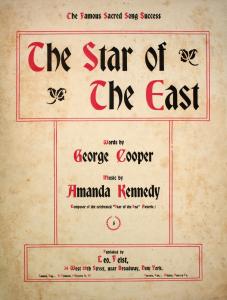
The Nutcracker (1892):
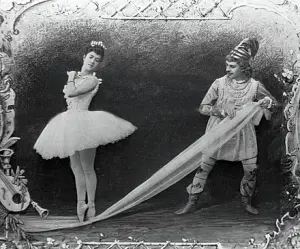
It is two-act classical ballet by Pyotr Ilyich Tchaikovsky, set on Christmas Eve at the foot of a Christmas tree in a child’s imagination. The plot is an adaptation of Alexandre Dumas’ 1844 short story The Nutcracker, itself a retelling of E. T. A. Hoffmann‘s 1816 short story The Nutcracker and the Mouse King.
Gabriel’s Message (1897) A Basque folk carol, originally based on Angelus ad virginem, a 13th or 14th Century Latin carol, it was collected by Charles Bordes (pub. Paris 1897) and then paraphrased into English by Sabine Baring-Gould (pub. 1922), who had spent a winter as a boy in the Basque country. The tune is called “Gabriel’s Message”. It is commonly performed in an arrangement by Edgar Pettman published in 1922.
The angel Gabriel from heaven came,
his wings as drifted snow, his eyes as flame;
“All hail”, said he, “thou lowly maiden Mary,
most highly favoured lady.” Gloria.
20th Century
Babes In Toyland (1903)- Broadway production opened at the Majestic Theatre on October 13 and ran for 192 performances. Babes is an operetta composed by Victor Herbert with a libretto by Glen MacDonough, which wove together various characters from Mother Goose nursery rhymes into a musical extravaganza.
Notable Film adaptations include:
Babes in Toyland (later reissued as March of the Wooden Soldiers) (November 29, 1934) starred Laurel and Hardy
Walt Disney‘s Technicolor 1961 film production starred Bolger, Sands, Funicello, Jillian, Calvin, Gene Sheldon and Ed Wynn.
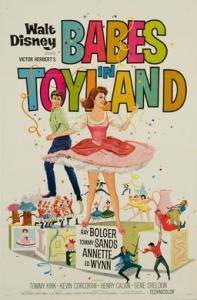
Go Tell It on the Mountain: (1909) The earliest known publication of the song is attributed to John Wesley Work, Jr. (1871-1925). The earliest printed version of “Go Tell” appeared in Thomas P. Fenner‘s Religious Songs of the Negro as Sung on the Plantations (new edition, 1909).
Go tell it on the mountain, over the hills and everywhere;
go tell it on the mountain, that Jesus Christ is born.
The Twelve Days of Christmas (1909): A large number of different melodies have been associated with the song, of which the best known is derived from a 1909 arrangement of a traditional folk melody by English composer Frederic Austin.
On the second day of Christmas my true love sent to me
Two turtle doves,
And a partridge in a pear tree.
On the third day of Christmas my true love sent to me
Three French hens,
Two turtle doves,
And a partridge in a pear tree.
Subsequent verses follow the same pattern. Each verse deals with the next day of Christmastide, adding one new gift and then repeating all the earlier gifts, so that each verse is one line longer than its predecessor.
- four calling birds
- five gold rings
- six geese a-laying
- seven swans a-swimming
- eight maids a-milking
- nine ladies dancing
- ten lords a-leaping
- eleven pipers piping
- twelve drummers drumming
We Wish You a Merry Christmas : (1909) The Bristol-based composer, conductor and organist Arthur Warrell (1883–1939) is responsible for the popularity of the carol. Warrell, a lecturer at the University of Bristol from 1909, arranged the tune for his own University of Bristol Madrigal Singers as an elaborate four-part arrangement, which he performed with them in concert on December 6, 1935. His composition was published by Oxford University Press the same year under the title “A Merry Christmas: West Country traditional song”.
We wish you a merry Christmas
We wish you a merry Christmas
We wish you a merry Christmas and a happy new year
Good tidings we bring to you and your kin
We wish you a merry Christmas and a happy new year.
It was sung by mummers – townsfolk who would go about singing from door to door to request gifts. An example is given in the short story The Christmas Mummers (1858) by Charlotte Yonge:
When at last they were all ready, off they marched, with all the little boys and girls running behind them; and went straight to Farmer Buller’s door, where they knew they should find a welcome. They all stood in a row, and began to sing as loud as they were able:
I wish you a merry Christmas
And a happy New Year,
A pantryful of good roast-beef,
And barrels full of beer.After they are allowed in and perform a Mummers play, the boys are served beer by the farmer’s maid.
The Holly and the Ivy (1909): The version which is now popular was collected in 1909 by the English folk song collector Cecil Sharp in the market town of Chipping Campden in Gloucestershire, England, from a woman named Mary Clayton.
The holly and the ivy,
When they are both full grown,
Of all the trees that are in the wood,
The holly bears the crown.
A movie was made called The Holly and the Ivy (1952) In the film an English clergyman’s neglect of his grown children, in his zeal to tend to his parishioners, comes to the surface at a Christmas family gathering. (IMDB)
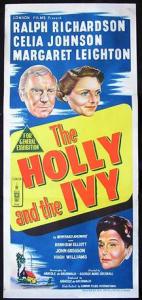
“Auld Lang Syne” (1921): Peaked at No. 5 on one of the top-selling music charts in December 1921. Written by Robert Burns as a Scots-language poem in 1788 and set to the tune of a traditional folk song.
Should Old Acquaintance be forgot,
and never thought upon;
The flames of Love extinguished,
and fully past and gone:
Is thy sweet Heart now grown so cold,
that loving Breast of thine;
That thou canst never once reflect
On old long syne.

“Parade of the Wooden Soldiers” (1922) Parade of the Wooden Soldiers, is an instrumental musical character piece, in the form of a popular jaunty march, written by German composer Leon Jessel, in 1897. The Vincent Lopez Orchestra version peaked at No. 3 on the pop singles chart in September 1922.
Ding Dong Merrily on High: (1924) The words are by the English composer George Ratcliffe Woodward (1848–1934), and the carol was first published in 1924 in his The Cambridge Carol-Book: Being Fifty-two Songs for Christmas, Easter, And Other Seasons.
Ding Dong! merrily on high
In heav’n the bells are ringing
Ding, dong! verily the sky
Is riv’n with angel singing
Gloria, Hosanna in excelsis



